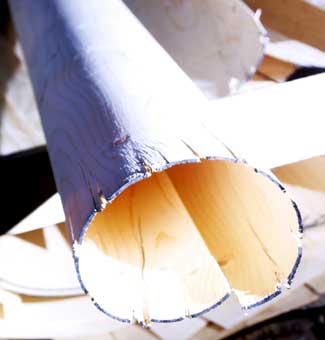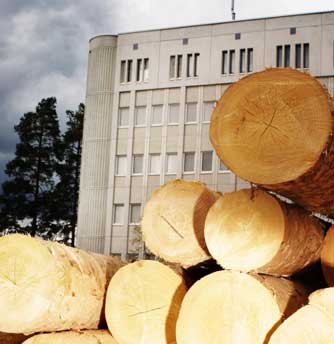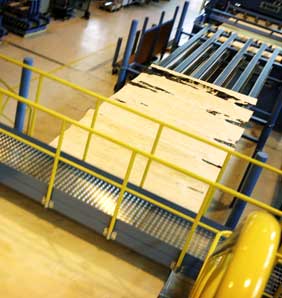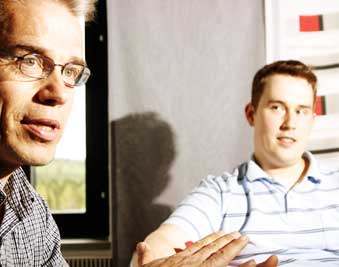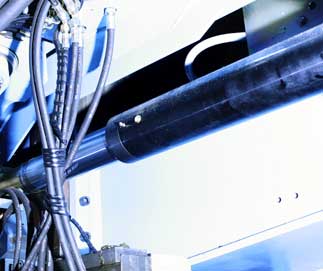Treading on thin wood
Finnish Raute has been in business for almost a hundred years. In the past couple of decades, the family-owned company has narrowed its focus.
Finnish Raute has been in business for almost a hundred years. In the past couple of decades, the family-owned company has narrowed its focus.
It is fitting that Rautehas found its own niche in the market, or its own slice of the pie, as its business is making machines that, simply put, can cut a log as thinly as possible.
The company is headquartered in Nastola, Finland, approximately 120 kilometres from Helsinki. It is one of those places that you don’t just happen to drive by, you need to know where it is. The tallest building in the neighbourhood, the headquarters is surrounded by Finnish forest. From here Raute delivers machines to its customers globally, generating annual sales of about 80 million euros.
Finland has always stood on its “wooden leg,” and Raute is part of Finland’s successful forestry cluster, which includes major pulp and paper companies as well as industry companies that manufacture paper machines.
Raute’s core operations comprise manufacturing processes for veneer-based products. Raute’s customers can get complete production plants, production lines or just parts of machinery and equipment or/and measuring technology.
It’s an engineer’s world where things are measured in thousandths of millimetres and milliseconds. Research and development is focused on slicing off parts of them.
“The key variables in our customers’ industry, when they are making veneer or plywood or floorings, are efficiency, quality, reliability and speed,” says Markku Pärssinen, development engineer at Raute. “Some products may require plywood that is just 0.5 millimetres thick. That means that the individual layers are 0.2 millimetres.”
Pärssinen leads us acrossthe yard to one of the buildings. He wants to demonstrate the new Raute line. After climbing the stairs up to the bridge, Pärssinen points to a lone operator sitting on top of the lathe.
“Our strength is that we can control the entire process, from when the wood arrives here to when it’s shipped out,” he says. “We can truly be in control of the process. The one operator that manages the process, controls it to the last 0.01 millimetre.”
“Let’s roll,” he yells to the operator.
A log is scanned and then moved to the veneer lathe. The lathe blade cuts the log, sending a 10-metre-long and a several-millimetres-thick carpet of veneer into the line, all in a matter of seconds.
Before the first part of the veneer has reached the cameras that check the quality, a new log has already been caught by the spindles and has reached the edge of the lathe’s blade.
As the new log is being turned into veneer, the remainders of the previous log drop onto the floor. That and the other green waste is used, for example, by the pulp and paper industry.
Another current development is that Raute’s customers want to be able to use more of the logs and use logs that are smaller, says Pärssinen. The average size of the logs is going down, as companies use more and more plantation trees.
For this purpose, Raute has developed a new production line that makes it possible for the operators to control the process to the tiniest detail. The new system can also handle up to 20 cycles per minute.
According to Pärssinen, Raute can supply an entire range of turnkey mill deliveries from log cutting to panel packing.
“In our business,there are very few competitors that can really supply complete plywood or LVL (laminated veneer lumber) mills,” says Pärssinen. “But naturally, there are companies that can provide our customers with different parts of the production lines.”
Raute has offices on four continents and manufacturing in Finland and Canada. In Africa, the one continent without a Raute office, the company is represented by a sales agent.
The company is family-owned, but a part of its shares are quoted at the Helsinki Stock Exchange. That gives it the flexibility to make quick decisions, and enough bargaining power to expand by acquisitions, should that be necessary.
The business volumeof Raute follows the fluctuations in investment activity in customer industries. New investment demand will be created by the ongoing relocation of plywood production to the plantation wood areas in the southern hemisphere and by the use of new wood species, such as eucalyptus.
“Currently, Raute’s main market areas are North America, Russia and Western Europe,” says Pärssinen.
Like many other manufacturing companies, Raute also wants to develop its service and maintenance side of the business, to create new opportunities and to guard itself against the fluctuations of the business. One part of that is the modernization of existing customers’ plants.
“Things are looking good,” says Pärssinen and smiles. “Not that we would turn down an order, but we’re booked solid for the rest of the year.” That’s got to be good, any way you slice it.
SKF’s electro-mechanical actuators
When Raute’s new production line feeds a log to the blade, the action involves a five-tonne bench that needs to be moved quickly into the right place. To make sure that the operator can get to the 0.01 millimetre accuracy, Raute moved away from hydraulic actuators.
Instead, they have been replaced by two of SKF’s new electro-mechanical actuators that use planetary roller screws. The roller screw converts rotary motion into linear movement.
“They are faster and more accurate than the hydraulic actuators, and they are environmentally friendly,” says Jukka Antila at SKF Multitec Finland. “All it takes to service one is 20 grams of grease, once a month. The electro-mechanical actuators are also more efficient, which make them save energy and energy costs.”
It took Raute and SKF almost three years to develop the current actuators to fit the needs of Raute and its customers.


